Testimonies
Here is a selection of testimonies submitted to us via e-mail or Facebook, and originally published on our Hungarian-language website. These testimonies were selected and, unless stated otherwise, translated into English by Gwen Jones. To submit a story, please write to bertalan@ceu.edu.
2014. April 08., Tuesday
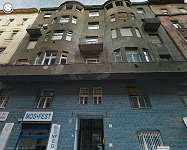
Ernő Stern was born in 1993 in Dvorníky [in Hungarian Nyitraudvarnok], and Janka Silberer was born in 1888 in Hlohovec [Galgóc]. Both towns are today in Slovakia. They met at a family wedding, married in January 1905, and had three children: Magda (born 1909), Lili (born 1911) and Laci (born 1913). After World War I, they moved to Budapest, to Sziget Street 11.
Lili, who changed her name to Lilla Sz. in 1934, wrote and recorded these memories for her grandchildren in 1996. The following quotes come from here.
“All three of us went to the elementary school on Sziget Street. One year, I could see into my classroom from our balcony, the school was directly opposite the house. I can still remember one of the teachers, Jolán Purjesz, and she had a sister Margit Purjesz. Maybe they were twins.
The third floor of the house was in fact the fourth floor. The first floor was called a half floor, and so the second floor was called the first. I can remember these neighbors and residents: Mrs Dudosits, the Hauser family, the Elek family, the Somló family, the Lorschy family, the Simon family, the Stella family, the Stark family, the Eiser family and later, during the war, the Práger family and the Sólyom family.
For us, the most important was the Schreiber family, the house supervisor. Their son Jenő was a good friend of ours. He later took the name Sasvári, and I’ll write about him later.
Our next door neighbours were the Elek family, and we were only on greetings terms with them. Our friend Éva Somló lived above us, and our parents got on well with the Stella couple, Gyula the husband and his wife Aranka Aradi, both of whom were actors. Our parents also got on pretty well with Jolán and Margit Eiser.”
Magda got married and moved to Pozsonyi Road with her husband. In 1940, their daughter Kati was born, and in 1943, their son Dénes. In 1944, Magda’s husband helped her and her children to go into hiding, and thus luckily they were not taken away.
In 1942, Lili married Ferenc (Franci) Lengyel, the great love of her life. From that point on, until her second marriage, she was called either Mrs. Ferenc Lengyel or Lili Lengyel, and this is the name that was recorded in Dachau as well.
The wedding lunch was held at Sziget Street, and Mama Janka—or Mimi, as her children called her—roasted a goose. The young couple rented an apartment in Buda, on Vérhalom Street, and lived together there happily for a very short period of time. Franci was called up for forced labor service, and never returned. For a long while, Lili never knew what had happened to him, and even today there is no precise information about his fate, but at the time, all that happened was the letters and postcards no longer arrived, and there was no other news of him either.
“I lived through the first air strikes in Vérhalom Street”—Lili’s recollections continue—“in September 1943. The next day, huge numbers of people went on a pilgrimage to Rózsadomb Hill, because Lajos Zilahy’s villa had been bombed into ruins, which was still something of a ‘novelty.’ I soon had to leave my Rózsadomb Hill apartment, and moved down onto Sziget Street. After the war, I couldn’t go back to Vérhalom Street, I couldn't bear to ever see that house again! In any case, it was bombed it during the war.
Life went on. The political atmosphere swung heavily to the right, and one decree followed the next. Franci’s parents had to leave their apartment on Lágymányos Road, because it wasn’t in a ‘yellow-star house,’ and they too moved into Sziget Street. My mother-in-law was already terminally ill with cervical cancer. We kept the truth about Franci from her for a long time, I made up stories, and until their deaths, they never knew what had happened, just like in Tibor Déry and Károly Makk’s film Szerelem (Love).
My poor mother-in-law survived the terrible bombings in the third-floor apartment, and which were targeted at Nyugati railway station. My little, old father-in-law sat next to her, holding her hand, and never came down into the basement air raid shelter. My mother-in-law and my Father died one after the other, Father had been taken onto forced labor service doing some ditch-digging, which was too much for his frail body. He died in his sleep at the age of 61. I couldn’t attend either funeral. Later, after the war, Dad’s sister Auntie Berta erected a gravestone for him. I couldn’t find the grave of either my mother-in-law or my father-in-law who, poor man, one day left home while I was already in a concentration camp, and never returned. What happened to him remains a mystery.
I will never forget October 15, 1944. In the morning, Horthy made his proclamation which, in practice, meant breaking with the Germans. Every resident of the house celebrated in happiness, that finally it was over, over… and now I’ll return to Jenő Schreiber (later Sasvári), the son of the house supervisor, our good friend. At the time he had the rank of lieutenant, and in his morning euphoria in the corridor, he kissed my mother right and left. At the time, this was a very brave thing to do. Then in the afternoon came the cold shower: Szálasi and the Arrow Cross had taken over power.
Then came the nightmarish Arrow Cross times, with permanent fear and vile decrees. One day, three men rang at the door, and asked me to let them in. They had escaped from the [internment] camp in Kistarcsa, and had already tried at a number of apartments, but with no luck. I let them in, but in the afternoon there was an air raid and everyone hurried down to the basement. The three men also came down, and somehow managed to escape into the basement of another house. I never saw them again. One was called Márványi, but I don’t remember the others.
Another ‘eternal mystery’ story: armed Arrow Cross juveniles went round the house ringing on all the bells, looking for Jews. My mother also opened the door to them. They looked her up and down and asked her whether there were any Jews in the apartment, and then left. Meanwhile, the older Jewish female residents of the house were being rounded up, and were later shot into the Danube. By some miracle, my Mother was not taken way, and the only logical explanation we could find for this was that perhaps our younger brother Laci had been the classmate of one of the Arrow Cross boys, who recognized her, who knows?”
Magda explained the story differently: during the siege, a Wehrmacht combat unit moved into Sziget Street 11, and their leader, a captain, who was a literature teacher in civilian life, had held long conversations about Goethe, Heine and Rilke with Janka, who spoke excellent German and was very knowledge about about European culture. This gave her a certain level of protection, and the deputy concierge, Bese, didn’t draw the Arrow Cross’s attention to this apartment.
In December 1939, Laci escaped to Palestine and became a British soldier, and fell into German captivity. He survived the war as a PoW, and then returned to Palestine in 1945. He wanted to reunited the family there. Janka received the travel permits in 1946, at the age of 48, and spent one year in Jerusalem, but she missed Sziget Street, her two children and grandchildren, and the ladies next door. Security had seriously deteriorated in Palestine, and Laci didn’t want to put his family in danger, and so in 1947 he sent his mother back home, and in 1948, he too returned to Budapest, not long after the formation of the state of Israel.
“There were countless people in the basement”—writes Lili—“and in between two air raids the younger ones, including myself, had to help putting out fires and carrying stuff to nearby houses. The deathly quiet on the street was terrifying, not a soul anywhere, and the smell of death. Our area was heavily bombed because it was close to Nyugati railway station… where, while we still hoped, Franci would return, and I would often go there and wait for the trains, I put up his photograph and name, the name of the company in which he served, in case anyone knew anything and could tell me (the station was full of such photographs)… Ever since then I still can’t look at scenes in films of people returning from war and embracing!”
Magda’s apartment on Pozsonyi Road was not a yellow-star house, and so they too moved into Sziget Street in 1944. During the bombings, there were frequent Arrow Cross raids, which is why the four-year-old Kati and Dénes, who wasn’t even one, were kept far apart in the basement. They found a good hiding place for Baby Dénes: during the raids, they put him under an upturned trough which they then sat on, and it didn’t even occur to the Arrow Cross to see whether there was anything there in the trough. Because of the Arrow Cross raids, all this was truly very risky, which is why Magda’s family soon took his family away from there and hid then on Jászberény Road, in the basement of the Orion factory. Janka never went down into the basement during the bombings.
“During those times, Magda Sólyom moved into the house with her mother and two sons, János and Péter”—continues Lili. “Her husband had fallen on forced labor service. We became very close friends and I spent lots of time at theirs, the two boys were still small guys. After the war and deportations, I learned that they survived the Arrow Cross times in a protected house, and then emigrated to Sweden. We met again in Stockholm in 1982, thirty-eight years later, and cried on each other’s shoulders. János Sólyom had become a famous pianist, while Peter was an environmental engineer.
On April 5, 1944, we had to wear the yellow star. Not long after, I was kicked out of my job, which was also prescribed in the decree. Of course, life wasn’t easy with a yellow star on, you couldn’t get on the first car of the tram, and loads of shops had signs in the window: ‘Jews not served here,’ and every day there were more and more humiliating decrees. I didn’t get any sort of protection letter. I first heard Wallenberg’s name after I was deported.
In early November, we heard a huge explosion: Margit bridge had been blown up.
And not long after that came deportation. At dawn on November 9, the assistant supervisor Bese strolled up and down the corridors, saying we should line up in the courtyard. Silly naïve goose that I was, I took with me my PhD certificate in chemistry, as if Germany chemical factories were waiting just for me. Four-five young people from the house gathered together in the courtyard.
Our first journey took us to the underpass which still remained at Margit Bridge. Here, an Arrow Cross chief asked us who had a Swedish or Swiss protection letter. Whoever had one, naively took it out, and he tore them into tiny pieces. We were marched over the Chain Bridge, which was still standing, and to the Óbuda brick factory. We spent the first night there, on the ground between the scaffolding for drying bricks. Many people had already committed suicide there with some sort of poison. In fact I also had a small bottle of cyanide.”
Lili was in a number of camps in the Dachau area. She was liberated on May 1 by American soldiers. It took weeks for her to put weight back on, and with the rest of her fellow inmates, they set off back for home. She knew nothing about her Mother and siblings.
“We got on train after train, and arrived in Pest. The train arrived at Kelenföld, and from there we went on foot across the Manci bridge. My mother already knew I was alive because one of her friends had returned home a few days earlier on another train. My mother went out every day to the Manci bridge, and that’s where she fell…
It was August 20 when we arrived, and I approached Sziget Street in fear. I didn’t know whether the house was still standing, or who was left. In a fantastic turn of fate, before I even arrived there, I ran into my cousin Györgyi on one of the corners, who told me that my Mother and Magda were still alive.”
After liberation, Magda had another child, Janka returned home from Jerusalem, and Lili never made it to Israel, but remarried and had a daughter, Ágnes. Laci also came home, married, and they had a daughter, Zsuzsanna. Neither Lili nor Laci ever lived again on Sziget Street. Magda’s apartment on Pozsonyi Road had been occupied by Russian soldiers, and so they returned to Sziget Street, and lived there until 1956. Janka died in 1955. Magda died in 1995, Laci in 1997, and Lili in 1998. All three reached a fine old age, and could spent plenty of time with their grandchildren.
2014. April 07., Monday
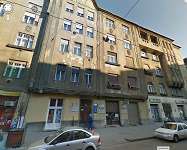
I think I am the only surviving resident of Népszínház 46 who remembers the past times, the pain and bitterness that unfortunately cannot be forgotten even when so much time has since passed. However, there were many residents in this house who helped wherever they could, and nobody moved out, but everyone somehow helped the Jews who lived and who were moved in there. My parents lived here from 1936 and I live here now, at the age of 84. Sadly, many no long remember those cruel times. I survived, but I won’t forget anything.
2014. April 05., Saturday
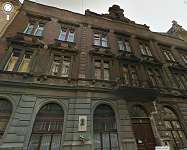
Szófia (then Hegedüs Sándor) Street 7 was also a yellow-star house. My parents, grandparents, aunt and cousins lived there in a double apartment. We ended up in this apartment by means of “exchange.” The people who had been living there before moved into our apartment at Teréz Boulevard 6. If I recall correctly, their family name was Böle. They must have been very nice people, because when we moved out, my parents put all our furniture into one room, and then sealed the room in the presence of the house supervisor. After liberation, when we returned there around January 20, my father opened up the room himself. Everything was untouched as we had left it.
My family was relatively “lucky.” My uncle died on forced labor service, but because of an illness. It’s another issue that in normal times, his illness would have been treatable.
My mother and aunt escaped in a way that bordered on miraculous. We had converted to Christianity which I do not mind and am not ashamed of, at the time this was a life-saver. They ended up on a deportation train and at the Hegyeshalom border station, met a transfer officer who, on religious grounds, accepted their papal protection letters (14 in total), and sent them back to Hungary. To this day, this is still almost unbelievable.
I was together with my cousin—both of us were 8 years old—and my grandfather, when little Arrow Cross turds picked us off the streetcar. They took us to the Szent István Boulevard Arrow Cross house and from there to the brick factory where a corporal got us out in exchange for money. Another extraordinary story.
After a few days of drifting about, the family were reunited and ended up first at the Sziget (today Radnóti Miklós) Street 25 house under Vatican protection. From there we ended up in the ghetto and were liberated there.
The apartment where we found a place to live also contained another family, with their five-year-old daughter. She is now my wife, and has been for the past 54 years. Of course, our earlier period of cohabitation only came to light when I was courting her.
Sadly, most of her family fell victim to the terror, many of them died in concentration camps. Her father however returned, but was physically broken and ill.
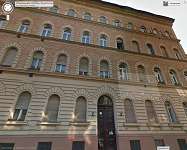
We were living in this house and didn’t have to move when it was designated a yellow-star house. We took relatives in. My father was on forced labor service and we heard nothing from him. My mother was deported from here and survived terrible ordeals, returning back here one year later. In the meantime, on December 1, I ended up with my grandparents and my aunt in the ghetto. We survived and returned to one of the rooms in our apartment in February 1945, the other three rooms were occupied by people we didn’t know. I was 8 years old at the time, and was initially very pleased to have so many other children around me. The adults tried to protect us from feeling threatened. But we soon realized the danger. In the fall, an elderly teacher in the house gave us lessons, until they took us away to the ghetto. The concierge, Sándor Szalay, was an Arrow Cross supporter, and I must mention his sole good deed: he saved my mother’s older sister from deportation. He told the other Arrow Cross men that they wouldn’t be able to use a hunchback woman with a heart problem, and they nodded that she could stay.

In remembrance of the Éliás family
My mother’s family lived at Váci Road 16 in a modest lodging of a single room and a kitchen overlooking the courtyard. Her father Miksa (1892-1945) was a barber without a shop, visiting his clients in their homes. Her mother, Mrs. Miksa Éliás, b. Irma Kohn (1895-1944) also went to manicure clients in their homes. They had two children, György Éliás (1920-1943) and my mother, Vera Éliás (1923-1990). They were not deeply religious, although they kept a more or less kosher household; once a year, at Yom Kippur, my grandmother – difficult to write this word as I have never known her – fasted and went to the synagogue. György completed secondary school, but Vera – though quite bright – was unable to continue her education beyond elementary school. She trained as a corset maker in the Hungária Elastic Fabrics and Bandage Factory, which was her last employer before the war.
Of her immediate family, only Vera survived the Holocaust. Her brother died in the Bor labor camp in 1943, as shown in the Yad Vashem database. Vera, together with many other women aged 18-40 years, had to report at the KISOK sports ground and, after a stop at the Óbuda brick factory, was force-marched across Hungary on foot and forced to dig trenches at Kópháza on the western border of Hungary. They were then transported to Lichtenwörth, a small village near Wiener Neustadt, Austria. There the deportees, mostly women, were kept in an empty, unheated factory building. They did not have to work, but they were systematically starved. Many died of starvation, or their lives were taken by illness. Vera was only 21; she said that her life was saved by her heavy boots and a quilt belonging to a kind woman in her 30s who took the young girl under her wing. It did not occur to her for a moment that she might not return home. The camp was liberated on April 2, 1945 and, ill with typhoid fever, Vera and her companion set off for home. The other woman died on the way, but Vera made it home and found her father alive. However, her mother who – in search of her daughter – had voluntarily joined one of the ‘death marches’ was missing. Vera became gravely ill, and was probably hospitalized for weeks; her recollection of this period was very weak. Her strongest and tormenting memory was the death of her father who contracted typhoid fever while caring for her. Someone returning from Bergen-Belsen brought news that her mother had been sent to the gas chamber. Vera had a few relatives in Budapest – those in the countryside had all perished – but with one exception she lost contact with them. She felt sorrow and remorse for her parents’ death all her life.
In memory of the lost family members, I attach surviving photographs of them, including one that shows my mother in the summer before deportation.
2014. April 04., Friday
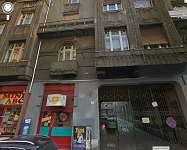
This house was owned by the Chevra Kadisha. We moved into our apartment here in 1936. Since most of the residents were Jewish, it was designated as a yellow-star house. Originally, there were 4 of us in a two-room apartment. However, when we had to display the yellow star, my older brother went underground and lived by the name of György Beke. Sadly, we didn’t see him again and so that we wouldn’t get into trouble, he only sent messages to us in a very roundabout way. On December 29, 1944, he died when a bomb fell on the entrance to Attila Boulevard 26 in Budapest. After the liberation, one of his friends got in touch (who had been our scout leader), and told us the story. This is how we got him exhumed and buried in a martyr’s grave.
A very kind family took us to the apartment, and we became great friends and lived crammed together without any problems.
My father was constantly called up for forced labor. We had no income whatsoever. My father’s earlier employer—who was naturally working illegally and helped us—took me on as a messenger on my father’s pay. When the curfew was introduced, he kept me on for a few hours a day. His name was Gábor Deák, and he was a shoe manufacturer and trader. His businesses were on Paulay Ede Street and Nyugati Station, where the Westend is today.
So there were Christian people who helped the persecuted.
Later I repaid him for his help and humanity, when he needed help.
In the yellow-star house, as children, we did not sense the terrors. We played in small groups.
Many afternoons, after the curfew came in, the adults who enjoyed and worked in the arts organized theatrical performances for us, which were certainly of a high quality. I sang operas and other songs too.
It’s interesting that many years later, in the early 1980s, I met a woman in Chicago who remembered these and other important experiences.
In early November, we had to move into a house under Vatican protection on Dohány Street and the corner of Rózsák Square. This was entirely unexpected and, as usual, I was not at home because I was working without wearing the yellow star. When I came home I saw that everyone in the house was lined up.
My parents signaled to me not to approach. I followed them from afar, and that’s how I learned they were taken to Wesselényi Street 8.
Life in the ghetto was a different story. But I should mention what happened after the liberation.
On the morning of January 18, Soviet troops entered the house. A few hours later, we could return to our apartment, where a family from Pestszentlőrinc were living. We asked them to go home, because we wanted to move back in. A few days later, this happened. Our apartment was empty, but all our property and furniture was stored in the dentist technician’s lab upstairs. I have to say that we were lucky, because not even a pin was missing. These people were honest too.
Sadly I can’t remember anything about anyone else who lived in the yellow-star house.
2014. April 02., Wednesday
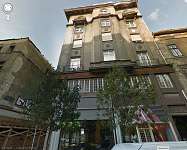
A rescuer: Gyula Legendy.
I was twelve when we moved, with my mother and one of my older sisters, on June 16, 1944 into the yellow-star house at Király Street 42. In mid-summer I developed a lung infection. Two weeks later I developed scarlet-fever. They wanted to take me to the orphans’ hospital, but my mother begged for a doctor to visit instead so I could stay at home. This meant I was quarantined for six weeks (and an official red notice next to our front door alerted residents to the danger of infection), and during the air raids, I wasn’t allowed down into the basement. Uncle Legendy, the concierge, secured a separate little basement entrance for us so we could huddle together downstairs during the air raids.
After the Szálasi putsch, as far as I recall on October 17, some Arrow Cross men entered the house. They ordered everyone down into the courtyard to look for weapons. All the apartments had to be vacated and we couldn’t take anything with us. They lined us up in the courtyard, and then we were escorted to Kertész Street 33-35. Women were led into one courtyard, men into the other. Later, soldiers took over guarding us. The rumor was that we’d be handed over to the Germans. We spent two nights in the courtyard, on the stone floor. On the third day they let us go, and so we hurried back to the Király Street apartment.
The Király Street concierge proved his humanity, in fact his braveness, when once, an Arrow Cross man was going from apartment to apartment with a policeman, collecting people together, allegedly for work. They also wanted to take my Mother away, and it is thanks to Uncle Legendy that this did not happen. He was able to convince the people hunters-that my Mother’s child had just developed a serious illness and could not remain alone.
In November, my Mother succeeded in obtaining a protection letter from the papal nuncio, and so we could move into a protected house. We were housed in a small ground-floor apartment at Dohány Street 47. My Mother placed me in a Red Cross children’s home on the corner of Andrássy Road and Munkácsy Street. On December 2, the Arrow Cross gathered the Jewish residents together in the courtyard. My Mother and older sister were at home. They tore up all the protection letters, lined everyone up and then made them set off to an unknown destination. While the Arrow Cross were checking the line of people on the street, my Mother and sister managed to step away from the line and, tearing the yellow stars from their clothes, mingle in with the passers-by. That evening, acquaintances of my sister’s took them in, a working-class family who lived at the end of Visegrádi Street. The next day, my Mother took me out of the children’s home because she had heard that the children had been taken away one night from a similar home. My sister’s benefactors couldn’t take any more people in, as they were already in danger for hiding more people. So we went back to Király Street 42. At night, Uncle Legendy let us back into our apartment. By day, my Mother and sister tried to find work as housekeepers, or any sort of job that would also provide accommodation. We went to the half bombed-out building of the Vigadó Theater, where an employment agency had been set up for refugees. They told the story that they had fled from the Russian occupation like many others, but had no strength to go on. My sister managed to find work in a household, but nobody wanted my mother and me. So during the day we rambled about, constantly in fear that someone would recognize us and hand us over to the Arrow Cross. In the evening, we asked to be let back in to the Király Street apartment. Uncle Legendy let us back in, and then for about a week, out of his kindness, we were relatively safe, at least for the nights.
A few days later (I think it was from December 10), Jews were not allowed outside the ghetto at all. As a final refuge, we went out to Újpest, where we looked for the Christian widow of one of my mother’s uncles. Aunt Teréz had a little tobacconists on Árpád Road near the water tower. We hoped she’d be able to help us hide until the Russians arrived. When she saw us, she took fright. Not only because we had lost so much weight and presented an appalling sight, but because, as we learned, there was an Arrow Cross house nearby, from where they used to come in and buy cigarettes. Because our relatives were spread all across they city, lots of people knew us in Újpest, and so someone might recognize us. So we were quickly bundled into the small apartment at the back of the shop. They gave us lunch and were wracking their brains over how to help us, when a cousin from Dunakeszi knocked at the door. We did not know this branch of the family. Aunt Teréz introduced us to Mariska as her friends from Szolnok who, after many hardships, could not take it any more and were looking for accommodation until they could return home. Mariska and her family took us in. Soon after, fighting came to Dunakeszi and on December 28, we were liberated there.
2014. March 31., Monday
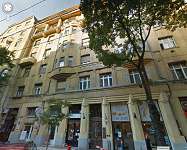
We had to leave the yellow-star house at Ó Street 48 in late October 1944. We lived there with two aunts and three cousins, and Arrow Cross youth escorted us to the yellow-star house at Pozsonyi Street 16 or 18.
Here 16 of us lived in one room. Somehow my Aunt Regina joined us (she had fled from Germany), as did Aunt Ilona's elderly mother-in-law, and another cousin who was about the same age as me.
We got on relatively well together, although of course the crammed conditions made our life difficult. Problems were mostly around use of the kitchen, since there were more than ten people living in the other room of the apartment, and at meal preparation times the women thronged around the small stove, which worked, luckily.
One day my aunt’s elderly mother-in-law had a hernia protrusion, and naturally a warm cover could not ease her strong pains. We couldn’t call a doctor—who wouldn’t have been able to help anyway—and so my aunt asked me to go out in my leather jacket “without a star,” and try to find a way to get her into hospital. By a stroke of luck, I managed to fulfill her request, and accompanied her, moaning with pain, to the emergency hospital on the corner of Wesselényi Street and the Boulevard, entrusting her to two hospital employees hurrying in front of me with a stretcher. She was operated on immediately, and as far as I know, she managed to survive the rest of the siege of Budapest in the ghetto hospital.
Around noon one day, a state of agitation took over. News spread that people in military uniforms and boots had entered the house, whose intention we could only suspect. Upon hearing this news, my Aunt Rózsi immediately left the house, and Aunt Ilona didn’t hesitate much either. Even today I can still remember the image of her climbing down from the street-facing window of our high first-floor apartment and, with open arms, asked us to pass her three-year-old daughter down to her, who then followed her down the street. And that’s how the family left, escaping into nothing, and we learned later that they had found refuge in the nearby yellow-star house at Főnix Street 5.
In the ever-roomier apartment I was left with my Aunt Regina from Germany, but I don’t remember how long for. Maybe 8-10 days. Armed youth with Arrow Cross armbands appeared in the house again, and ordered all the residents to line up immediately in front of the house. I picked up my briefcase that contained my belongings and joined the line. We turned left onto Szent István Boulevard (and luckily, not in the other direction towards the Danube, but at that point we didn’t realize how lucky we were), and among lines of staring crowds, we went to the 6th-7th district central ghetto, where they dumped us behind the ghetto gates sealed with wooden boards.
I won’t continue with the story from here, since this is where the yellow-star house chapter comes to an end. In the ghetto however, every house had to have a star, how could it not be marked with a yellow star (but I don’t remember this detail precisely, who paid attention to what was on the front gate?).
But to finish I must describe the emotions I felt, and which I still feel today when I recall the scene.
In the ghetto house, towards the end of January (?), because of the bombings, I spent a couple of days in the basement air-raid shelter, we had to spend our time in the dark in the hiding place, with only a few oil lamps here and there. One could sleep well in the dark, and hunger is a good sedative.
One morning, I woke up to find that the hiding place was empty. Climbing up the stairs into the blinding daylight, the first thing that grabbed my attention was the pile of wooden boards piled up on top of one another. Of course I didn’t understand what had happened or how, or why…?
And then I saw the man dressed in a completely unknown kind of military uniform, with a fur cap on his head and probing in front of him with his gun …
And then I understood, I understood why the hiding place had emptied out, where the pile of wooden boards had come from, the unknown soldier, whom I DID NOT HAVE TO FEAR, and most important of all that my fate had been transformed, in that I had been a persecuted (why?) child who had now become a free citizen.
“Imprinting,” says Lorenz Konrad, but who cares what it’s called!
I can only think of the Soviets, the state of mind described above!
Olga Mária Magyar
2014. March 27., Thursday
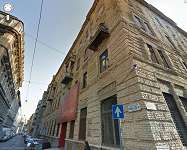
We lived in Paulay Ede Street 41, 3rd floor, no. 5: my father, Imre Quitt, my mother, born Magda Földes, and me. The house was owned by Fried and employees of the Fried leather factory lived in rented apartments there. Sometimes my father’s two brothers and their families also lived with us. Sadly, I am now the only remaining survivor. The other relatives fell victim to the war and anti-Jewish hatred. Let these few lines from me be a stone left as a commemoration on their graves, so that we never forget our memories of them.

The house was designated as a yellow-star house on June 21, 1944. Since the twenties, Henrik Vajda and his wife, Andor Bárdos and his wife Jolán Vajda and their son Zoltán born on January 13, 1924, lived at Akácfa Street 59, first floor, apartment no. 2. Among the old residents, Henrik Vajda, Bárdos Andor and his wife Jolán remained in the apartment. Mrs. Vajda died years later.
Zoltán was on forced labor service, in division 101/99. His division was stationed at the Scottish school on Vörösmarty Street. They went to work in the Hős Street military base. Later, after a long series of hardships, he was liberated at Mauthausen-Günskirchen, and returned home to the apartment. Andor Bárdos was taken away during the Arrow Cross reign, together with the other residents, to the highway to Vienna. He was shot in December at the “Ilona farmstead” near Hidegség [at the border with Austria]. I learned this from Géza Kertész, born 1928, a ground-floor resident who had been taken away with them.
During the summer forcible relocation [into yellow-star houses], the family’s distant relatives moved into this apartment.
Aunt Ida (Mrs. Baumöhl), and Aunt Emma Erdély, who had been a teacher in the orphanage.
Aunt Nelli Erdély and her daughter Olga, József Mattát and his wife Elza, also ended up in the apartment. From August until the end of October, Éva Bárdos and I (Márta Bárdos) went over to see them for lunch, from Eötvös Street 2.
On January 4, 1945, after an Arrow Cross attack, I ended up at the Swedish protected house at Pozsonyi Street 12 in a first-floor apartment, where there were already 36 people crammed in together. I registered with the house supervisor, Dr. Emil Hermann, who added me to the list of residents. The daily ration of bread was 50 grams per person.
During the siege, bombings and shootings, the residents spent most of their time in the coal cellar. In the middle room, Uncle Vajda and Aunt Jolán slept on a set of twin beds. Laid across the end of the beds was a divan where Aunt Ida slept, and which she shared with me after I moved in. Until the very last day, I refused to go down into the cellar.
On January 17, Red Army soldiers broke through the back wall of the refuge at Nagyatádi Szabó (today Kertész) Street and immediately pulled out the telegraph lines. A Soviet soldier shot through the window at the German air-defense guns erected in the empty plot opposite, and they shot back. The solider died and was laid out on my divan. On that evening, I went down to the cellar.
There was no electric lighting, and there was an oil lamp burning in the middle of the front room so we could find the way to the WC. We used some of the existing oil to burn in the lamp, and the rest to roast potatoes in a skillet.
Bearing in mind that Aunt Jolán and family had been living in the apartment before, there were some food reserves in the pantry which, because of the lack of supplies, ran out very quickly.
On the last day, Uncle Vajda opened a tin of liver conserve, cut it into four, and that’s what we ate: him, Aunt Jolán, Aunt Ida and I, with a slice of bread.
The next day, Soviet soldiers brought potato pasta (“grenadír mars”) in buckets, which we gladly ate with our hands. They asked for girls to come forward and peel potatoes.
I would have volunteered, thinking that they had to fight and had better things to do than peeling potatoes. But Aunt Jolán didn’t let me go. She knew from experience that they wanted the girls not only to help out in the kitchen.
After the liberation, most of the family moved back into their own apartments, but József Mallát and his wife Elza stayed and rented the far room next to the street.
In the middle of summer 1945, Uncle Vajda died. Uncle Bandi (Andor Bárdos) was unable to survive the experience of the highway to Vienna, and so it was just Aunt Jolán who greeted their son Zoltán returning from Mauthausen. On May 1, 1946, Zoltán married Lívia (Lili) Grósz in the Heroes’ Church. On February 24, 1950, their daughter Judit was born. After a long illness, Lili died and Zoltán remarried. Aunt Jolán and Judit lived in this apartment until the summer of 1981.
On January 18, 1945, the plank boards surrounding the ghetto were knocked down, and Uncle Misa, who lived at Akácfa Street 20, came to get me and together we went through the demolished gate on Wesselényi Street back to our Eötvös Street 2 apartment. Aunt Annus (Mrs. Weiner) also joined us.
With Uncle Misa, I went back to Pozsonyi Road 12. There had been much shooting on Lipót (today Szent István) Boulevard, and the “battle of the Víg Theater,” which Béla Illés wrote about in one of his novellas.
The Pozsonyi Road apartment had been completely looted, we found nothing from the stuff we’d left behind. However, in the middle of the courtyard, there was a huge pile of dried peas. We stuffed them into an empty briefcase, and lived off these for days. There was a large stove in the kitchen of the Eötvös Street apartment, and lots of residents came to use it to cook. For fire wood, two of my uncles (Misa and Emil) used the beams of a house that had collapsed to light the fire. The only water was from a tap in the courtyard, and people queued up here for water.
The Soviet soldiers learned that Uncle Misa was a tailor. He used Aunt Annus Singer’s sewing machine to mend many uniforms, and in exchange they gave us the square soldiers’ bread.
They also bought a large piece of black leather to make gloves from. But the leather was too thick for the sewing machine. Later, the leather was used for my first pair of shoes, the sole of which was made out of car tire scraps, by Ignác Dániel, the shoemaker from Dombóvár.
A few days later, Uncle Emil walked into the Kőbánya Maternity Home, and I went with him too. We walked out there in heavy snow. On Teleki Square, we found ourselves under fire from a low-flying airplane, but luckily, the bullets missed us.
There were two rooms in the cellar of the Kőbánya Maternity Home. One was the ward where women gave birth. One woman had been brought here by relatives in a wheelbarrow. In the other room were rows of berths for the doctors, babies, and nurses, and a stand used for bread in bakeries. This is where the little babies in swaddling lay in rows, like loaves of bread. There was no space for me, and I so lay across the highest shelf.
Once, a Soviet soldier came with a beautiful horse who had a shrapnel injury.
“Vrach, vrach!,” he shouted. For want of a doctor, they called my Uncle Emil, who was a gynecologist.
Seeing the horse’s serious injury, he said “Kaput,” whereupon the soldier shot the horse in the head. The house supervisor immediately cut up the fresh meat. Finally, the midwives and workers had something substantial to eat. They prepared it with a tomato sauce.
My Uncle Emil received a nice piece of boned and trimmed meat, which he had sent with someone going into town to Misa and family at Eötvös Street 2 so that they too had something to eat.
One or two weeks later, we arrived home. Misa asked Emil:
“Where did you get that piece of beautiful beef?”
Laughing, Emil confessed:
“It wasn’t beef, but horse meat.”
And Misa started retching because he’d been forced to eat that “wasn’t kosher.”
Ever since I was a little girl, I’d had long hair almost down to my waist. During the many hardships, I managed to keep it clean. However, in the Maternity Home (a hospital!), I caught lice. Then I went back home to the Eötvös Street apartment. A nurse who lived nearby came to see me regularly. She rubbed my head with petrol, and used a fine comb to get rid of the lice. It worked.
My long ponytail was cut off in the summer of 1947, after my high school matriculation exam. I still have the hair wrapped in newspaper! They told me: “university students shouldn’t have ponytails.”
Later, I grew my hair long and wore it in a bun.
After we moved back in, the glass in every window had been smashed, and we stuck waxed wrapping paper up in the frames.
The surgery was lined with dark green linoleum. It was thick and filthy, and it fell to me to clean it. It wore me out, I wasn’t used to this work.
On March 15, 1945, I walked with Uncle Emil to Veres Pálné Girls’ Grammar School. The headmistress, Ilona Haitsch, allowed me to continue my studies. I finished Class VI that academic year. They issued me with a copy of a certificate that I’d completed Classes I-V.
Epilogue
In 1945, we started to live again, adapting to the changed circumstances.
We didn’t know anything about those who had been snatched away. Dr. Emil Komlós returned to his apartment at Eötvös Street 2, and continued to work as a gynecologist. Miksa Komlós returned to Dombóvár. He found nobody from his large extended family.
As I remained without parents, Uncle Emil took me into his care. I continued my high school studies at the Veres Pálné Girls’ Grammar School and graduated from Class VI in 1947.
For a while, Aunt Annus Weiner took care of our household. At weekends, she brought her grandson, Tibi Lichtmann, from the orphanage to be with us. Tibi’s father had been killed during forced labor on the Eastern Front, his mother in Dachau.
In 1950, the apartment was split into two. The room facing the courtyard was turned into a small kitchen, bathroom and entrance hall, with an entrance into the far room on the street side. In January 1951, I married my classmate, Elek Fehér. In 1955, we attached the room from Aunt Weisz’s apartment next door. And so the Eötvös Street 2x3-room apartment became a 3x2 room apartment, looking onto the street.
We lived here until March 1960. Our son András was born on October 13, 1954.
In March 1960, we exchanged apartments and moved one block down. I still live now at Teréz (formerly Lenin) Boulevard 12. I am now a widow, and live with my youngest son Zoltán, born January 9, 1963.